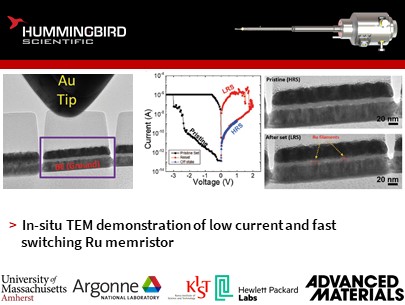Researchers at the University of Massachusetts, Amherst, Argonne National Laboratory, Korea Institute of Science and Technology, and Hewlett Packard Labs have demonstrated low current and fast switching capability in Ru-ion-mediated memristor device for the first time. The work was performed using Hummingbird Scientific’s TEM Biasing Manipulator holder and published in a prestigious journal, Advanced Materials.

The Ru memristor device was brought in contact with Au tip using the mobile probe of the TEM Biasing Manipulator holder and I-V measurement was performed by capturing high-resolution in-situ TEM images simultaneously. The data showed that the low current switching behavior is triggered by the movement of Ru ions back-and-forth in oxides (Ta2O5) during applied biasing polarity. The work demonstrates the high-performance capability of Ru-based memristor devices for the first time.
Reference: Jung Ho Yoon, Jiaming Zhang, Peng Lin, Navnidhi Upadhyay, Peng Yan, Yuzi Liu, Qiangfei Xia, J. Joshua Yang, A Low‐Current and Analog Memristor with Ru as Mobile Species,” Advanced Materials (2020). Full Paper
View All News

